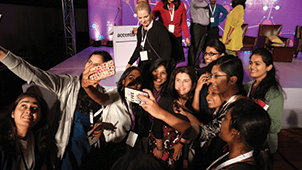Technology
Where Girls Go to Code
By Sarah Fister Gale
Nov. 22, 2016
 In late September, Accenture’s Ellyn Shook welcomed 1,200 new female engineers to the company at an onboarding event at its offices in India.
In late September, Accenture’s Ellyn Shook welcomed 1,200 new female engineers to the company at an onboarding event at its offices in India.
“That day was one of the most memorable in my career,” the consulting giant’s chief human resources officer said. The welcome party was hardly unique for Accenture, which has enjoyed great success in attracting female tech candidates. In 2015, the company set a goal that 40 percent of new hires — most of which are engineering roles — would be women by the end of fiscal 2017, then exceeded that goal a year early. As of August 2016, 41.1 percent of the 90,000 new hires at Accenture were women.
This accomplishment is especially impressive considering the dearth of women entering tech fields. According to data from CompTIA, a nonprofit association for the technology industry, more than 5.1 million people worked in core technology jobs in the United States at the end of 2015, but just 25 percent of those jobs were held by women. And the numbers appear to be dropping, not climbing.
“Despite being digital natives, girls’ interest in tech jobs decreases dramatically by the time they enter high school,” said Carolyn April, CompTIA’s senior director of industry research. The study shows just 18 percent of girls entering high school report an interest in a tech career, down from 27 percent in middle school.
If recruiters want to hire women into tech roles, they can’t wait until college to start looking for them, April said. Boston-based CompTIA encourages companies to begin engaging with girls as early as high school and even middle school by supporting tech curriculum development efforts, meeting with girls associations, and support summer camps and high school internship programs. “We need to raise awareness among younger girls that these are great careers,” she said.
Another popular option is partnering with Girls Who Code, a nonprofit group that hosts coding camps and immersion programs to attract girls to tech career paths. Girls Who Code and Accenture released research in October showing the number of U.S. women in technology jobs will fall to a new low over the next 10 years, despite efforts to close the gender gap in tech. The report, “Cracking the Gender Code,” identifies strategies to drive girls’ interest in computing, and includes things like supporting tech-focused summer camps geared toward girls, and offering all undergraduates on-campus and summer immersion programs in computing/coding.
“Too often girls don’t pursue computer science because they’ve never been exposed to it, or they don’t see the impact it can make on the world,” said Girls Who Code founder and CEO Reshma Saujani. “By actually embedding classrooms in today’s leading companies that create products girls use every day, we show them, ‘Look, you can do this. You can code this. This is a world that is open to you, and once you learn this skill set, the possibilities are endless.’ ”

Accenture is one of 60 companies that partners with Girls Who Code to support their camps and research efforts. The company is also increasing its presence on engineering-focused college campuses through sponsorships, participation in curriculum development, and hosting hackathons, innovation initiatives and other on-campus events. These long-term strategies help build relationships and brand awareness with female engineering students.
“You can’t just say, ‘We want to hire more women,’ ” Shook said. “We are trying to show these women that we are worthy of hiring the best talent.”
Hiring is just the first step. A report from the National Society of Women in IT shows 56 percent of women in tech leave their jobs mid-career, which is incredibly costly for the companies that train them.
To reduce that attrition, companies need to think more strategically about what women need in the workplace to succeed — and what is standing in their way, Shook said. She points to a conversation she had with a new mom who after returning from maternity leave asked Shook if the company would pay to have her breast milk shipped home when she was working at client sites.
Shook agreed, but the request spurred her team to look more closely at the true source of the problem: nursing moms being away from their children. A month later, the company implemented a policy that new parents don’t have to work outside their home city for the first year of their child’s life.
“That program reduced attrition among new moms by 30 percent in the first year,” she said.
In a similar effort, the company created a development track for female engineers in India to pursue a certified technical architect degree, which is one of the most highly sought-after skill sets in the tech world. The certification allows engineers to “write their own ticket and to work where and when they want,” Shook said.
It gives them more power to achieve the work-life balance they need to support their families while staying actively engaged in their career. The key is looking for the root cause of the problem, then figuring out how to address it, Shook said. “You can’t make significant improvements without disrupting the way you do things.”
That level of change can be difficult to achieve, but for business leaders who want to build a diverse and engaged workforce and a strong female engineering staff, it needs to be done, April argued. “They need to think more creatively about how they are going to feed their talent pipelines with female candidates,” she said. “There are no quick fixes, but organizations that advocate for women will see a strong return on these investments down the road.”
Schedule, engage, and pay your staff in one system with Workforce.com.